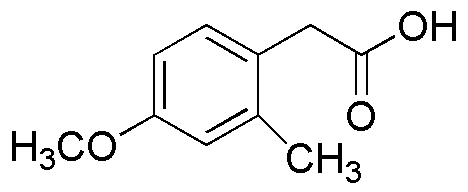4-Methoxy-2-methylphenylacetic acid is widely utilized in research focused on:
- Pharmaceutical Development: This compound serves as a key intermediate in the synthesis of various pharmaceuticals, particularly in the development of anti-inflammatory and analgesic medications.
- Agricultural Chemicals: It is used in formulating herbicides and pesticides, providing effective solutions for crop protection while minimizing environmental impact.
- Flavor and Fragrance Industry: The compound is employed in the creation of flavoring agents and fragrances, enhancing the sensory profiles of food products and personal care items.
- Biochemical Research: Researchers utilize this chemical in studies related to metabolic pathways, helping to understand its role in biological systems and potential therapeutic applications.
- Material Science: It finds application in the development of polymers and resins, contributing to the production of durable materials with specific performance characteristics.
General Information
Properties
Safety and Regulations
Applications
4-Methoxy-2-methylphenylacetic acid is widely utilized in research focused on:
- Pharmaceutical Development: This compound serves as a key intermediate in the synthesis of various pharmaceuticals, particularly in the development of anti-inflammatory and analgesic medications.
- Agricultural Chemicals: It is used in formulating herbicides and pesticides, providing effective solutions for crop protection while minimizing environmental impact.
- Flavor and Fragrance Industry: The compound is employed in the creation of flavoring agents and fragrances, enhancing the sensory profiles of food products and personal care items.
- Biochemical Research: Researchers utilize this chemical in studies related to metabolic pathways, helping to understand its role in biological systems and potential therapeutic applications.
- Material Science: It finds application in the development of polymers and resins, contributing to the production of durable materials with specific performance characteristics.
Documents
Safety Data Sheets (SDS)
The SDS provides comprehensive safety information on handling, storage, and disposal of the product.
Product Specification (PS)
The PS provides a comprehensive breakdown of the product’s properties, including chemical composition, physical state, purity, and storage requirements. It also details acceptable quality ranges and the product's intended applications.
Certificates of Analysis (COA)
Search for Certificates of Analysis (COA) by entering the products Lot Number. Lot and Batch Numbers can be found on a product’s label following the words ‘Lot’ or ‘Batch’.
Numéro de catalogue
Numéro de lot/série
Certificates Of Origin (COO)
This COO confirms the country where the product was manufactured, and also details the materials and components used in it and whether it is derived from natural, synthetic, or other specific sources. This certificate may be required for customs, trade, and regulatory compliance.
Numéro de catalogue
Numéro de lot/série
Safety Data Sheets (SDS)
The SDS provides comprehensive safety information on handling, storage, and disposal of the product.
DownloadProduct Specification (PS)
The PS provides a comprehensive breakdown of the product’s properties, including chemical composition, physical state, purity, and storage requirements. It also details acceptable quality ranges and the product's intended applications.
DownloadCertificates of Analysis (COA)
Search for Certificates of Analysis (COA) by entering the products Lot Number. Lot and Batch Numbers can be found on a product’s label following the words ‘Lot’ or ‘Batch’.
Numéro de catalogue
Numéro de lot/série
Certificates Of Origin (COO)
This COO confirms the country where the product was manufactured, and also details the materials and components used in it and whether it is derived from natural, synthetic, or other specific sources. This certificate may be required for customs, trade, and regulatory compliance.

